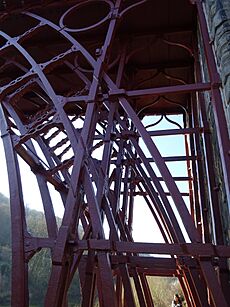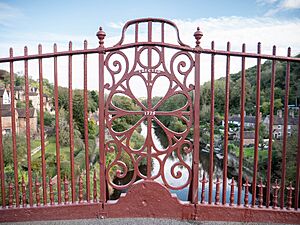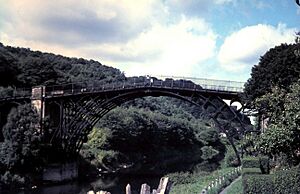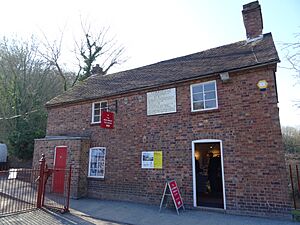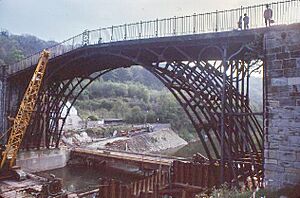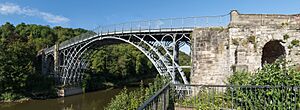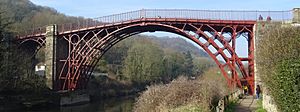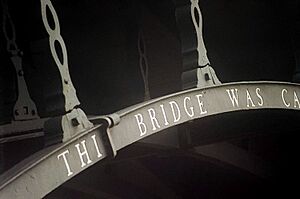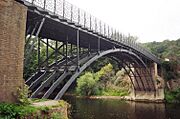The Iron Bridge facts for kids
Quick facts for kids The Iron Bridge |
|
|---|---|
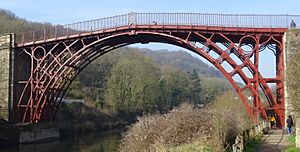
The Iron Bridge (February 2019)
|
|
| Coordinates | 52°37′38″N 2°29′08″W / 52.62735°N 2.48550°W |
| Carries | Pedestrian traffic |
| Crosses | River Severn |
| Locale | Ironbridge Gorge, Coalbrookdale and Ironbridge |
| Owner | Telford and Wrekin Council |
| Characteristics | |
| Design | cast-iron truss arch bridge |
| Longest span | 100 ft 6 in (30.63 m) |
| History | |
| Designer | Thomas Farnolls Pritchard |
| Constructed by | Abraham Darby III |
| Fabrication by | Abraham Darby III |
| Construction begin | November 1777 |
| Construction end | July 1779 |
| Opened | 1 January 1781 |
| Statistics | |
| Toll | Free public access since 1950 |
The Iron Bridge is a famous bridge in Shropshire, England. It was the first big bridge in the world made from cast iron. This amazing bridge crosses the River Severn.
It opened in 1781 and showed everyone that cast iron could be used for building. Because of its success, many other structures started using cast iron. Today, the Iron Bridge is a special symbol of the Industrial Revolution. This was a time when new machines and factories changed how people lived and worked.
The area where the bridge stands is called the Ironbridge Gorge. This deep valley was formed by ice a long, long time ago. It had lots of useful materials like coal and iron ore close to the surface. But building a bridge here was tricky because the river banks were unstable.
A man named Thomas Farnolls Pritchard suggested building a bridge from iron. After some worries about using iron, Abraham Darby III took charge of the ironwork. The bridge was built in just two years. It spans 100 ft 6 in (30.63 m) across the gorge, high enough for boats to pass underneath.
In 1934, the bridge was made a scheduled monument. This means it's a very important historical site. Cars were no longer allowed to cross it. People had to pay a small fee to walk across until 1950. Then, the bridge became public property.
For many years, the bridge needed a lot of repairs. But big restoration projects in the late 1900s helped protect it. The Iron Bridge, the nearby town of Ironbridge, and the gorge are now a UNESCO World Heritage Site. This means they are recognized as important to everyone in the world.
Contents
The Bridge's Story
How the Gorge was Formed
The Ironbridge Gorge was created at the end of the last ice age. A large lake overflowed, carving out the deep valley. This process brought valuable resources like coal, iron ore, and limestone close to the surface.
The River Severn was a great way to transport these materials. Because of this, the area became a key center for the new Industrial Revolution.
Early Iron Making
In 1709, Abraham Darby I discovered how to make iron using coke. Coke is a special fuel made from coal. This made iron cheaper to produce. Soon, Shropshire became a hub for industry.
The River Severn was important for trade. But it also made it hard to travel across the deep gorge. The closest bridge was two miles away. So, people wanted a new bridge to connect the industrial towns of Broseley and Madeley with Coalbrookdale.
Because of the river traffic and steep banks, the bridge needed to be a single span. It also had to be tall enough for ships. The unstable banks made building a bridge a real challenge.
The Iron Bridge was the first of its kind. But it wasn't the first iron bridge ever thought of. An iron bridge was started in France in 1755 but was too expensive. A small iron footbridge was built in Yorkshire in 1769.
The Idea for an Iron Bridge
In 1773, an architect named Thomas Farnolls Pritchard had a big idea. He wrote to his friend, John Wilkinson, who owned an ironworks. Pritchard suggested building a bridge entirely out of cast iron.
Pritchard usually designed things like fireplaces and monuments. But he had also designed wooden and stone bridges before.
In 1775, people raised money for the project. They collected between £3,000 and £4,000. Abraham Darby III, the grandson of Abraham Darby I, became the treasurer. He worked at the Coalbrookdale ironworks.
In 1776, a special law was passed by Parliament. This law allowed the bridge to be built. Abraham Darby III was chosen to make and build the bridge.
There were still some doubts about using iron. So, the builders looked at plans for stone, brick, or timber bridges. But no good ideas came forward. Eventually, they decided to go with Pritchard's iron design. The bridge's main span was set at 100 feet 6 inches (30.63 m). This was long enough to allow a towpath for horses pulling boats.
Building the Bridge
The building site was chosen near where a ferry used to cross the river. It had good approaches on both sides and solid ground. Sadly, Pritchard died in December 1777, just a month after construction began. He had been ill for over a year.
The bridge is made from five main cast-iron ribs. These ribs create the 100 feet 6 inches (30.63 m) span. The bridge used about 378 tons of iron. It has almost 1,700 separate parts. The heaviest parts weighed over 5 tons each.
Each part was cast individually to fit together. This meant that even "identical" parts could be slightly different sizes.
The stone foundations were built between 1777 and 1778. The iron ribs were put into place in the summer of 1779. The bridge first stretched across the river on July 2, 1779. It officially opened for people to use on January 1, 1781.
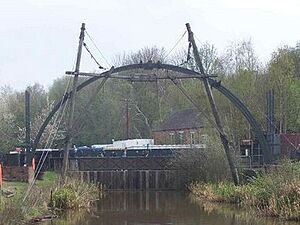
In 1997, a painting by Elias Martin was found. It showed the bridge being built in 1779. The painting showed a wooden scaffold with cranes in the river. These cranes lifted the iron ribs into place. The ribs were brought to the site by boat from Darby's factory.
In 2001, a half-size model of the bridge was built. This was for a BBC Timewatch TV show. It helped show how the original bridge was assembled.
How the Bridge was Designed
The bridge's design looks like a wooden structure. It uses five cast-iron ribs to create its 100 feet 6 inches (30.63 m) span. The way the rings interlock between the arches makes it a truss arch bridge.
About 378 tons of iron were used. There are almost 1,700 individual pieces. The heaviest piece weighs about 5.5 tons. Each part was custom-made to fit.
The decorative rings and shapes suggest that Pritchard was the final designer. Similar designs appear in other buildings he worked on. A foreman named Thomas Gregory drew the detailed plans for the parts. This led to the use of carpentry joints, like mortise and tenon and dovetails.
The two outer ribs of the bridge have words carved into them. They say: "This bridge was cast at Coalbrook-Dale and erected in the year MDCCLXXIX" (1779 in Roman numerals).
Two extra iron arches support a towpath on the south side. They also help let floodwaters pass through. A small path on the north side is carried by a stone arch.
What it's Made Of
The Iron Bridge is made of cast iron. Cast iron is very strong when it's pushed together (in compression). But it's not as good as steel or wrought iron when it's pulled apart (in tension) or bent. This is because cast iron can be brittle.
Later, puddled wrought iron became a better building material. It was used for bridges, rails, and ships. Then, in the late 1800s, new ways of making steel were invented. Steel became the best material for building.
How Much it Cost
Darby agreed to build the bridge for £3,250. This money was raised by people who supported the project. However, the actual cost was closer to £6,000. Darby, who already owed money from other projects, agreed to pay the extra cost himself.
But by the mid-1790s, the bridge was making good money. The tolls collected from people using it gave shareholders an 8% profit each year.
The Bridge Through the Years
After the bridge opened, the area around it changed. New roads were built, and the town of Ironbridge grew up at the north end. People started to visit the bridge, making it a popular sight.
Fixing the Bridge
In 1783, a wall was built to stop the north bank from sliding into the river. Cracks appeared in the stone arch on the south side in 1784. The ground in the gorge is very prone to landslides. People thought the sides of the gorge were moving inwards, pushing the bridge's feet together. So, repairs were done in 1784, 1791, and 1792.
In 1795, a huge flood hit the River Severn. All the other bridges nearby were washed away. But the Iron Bridge survived! Its open design allowed the floodwaters to pass through.
Later, in 1800, more repairs were needed. The stone arches were replaced with wooden ones to ease pressure on the main iron span. In 1820, these wooden arches were replaced with cast iron ones. The bridge continued to need repairs throughout the 1800s.
In 1902, a part of the bridge's side wall fell into the river. Another piece of the deck fell in 1903. A new concrete bridge opened nearby in 1909. This new bridge didn't charge tolls.
No More Cars
In 1923, experts said the main part of the bridge was in good shape. But they thought the metal deck was too heavy. They suggested reopening it to light vehicles after making it lighter. A weight limit of 4 tons was put in place.
However, many heavy trucks wanted to use the bridge. So, on June 18, 1934, the bridge was closed to all vehicles. People still paid tolls to walk across until 1950. Then, Shropshire County Council took ownership.
The money from tolls barely covered the cost of collecting them. There was no money for upkeep. The bridge wasn't cleaned or painted for many years. Because it was in such poor condition, some people even suggested tearing it down.
In 1967, the Ironbridge Gorge Museum Trust was formed. Its goal was to protect the industrial history of the gorge. The Trust helped get money to repair the bridge.
Making it New Again
Between 1972 and 1975, major repairs were done to the bridge's foundations. This cost £147,000. Engineers decided to build a strong concrete arch under the river. This would stop the bridge's ends from moving inwards.
The road surface was replaced with lighter tarmac. The stone parts were fixed, and the old toll-house became an information center. In 1980, the bridge was painted for the first time in the 20th century. All the work was finished for the bridge's 200th birthday on January 1, 1981.
From 1999 to 2000, the bridge was covered in scaffolding. This allowed English Heritage to examine it closely. It was also repainted, and small repairs were made.
In January 2017, English Heritage announced a huge £1.2 million restoration project. This was their "biggest ever conservation project" for the bridge. By 2018, the cost was £3.6 million. The project fixed the ribs, arches, stonework, and decking.
Surveys showed that the bridge was under stress. This stress came from its original construction, ground movement over hundreds of years, and even an earthquake. Besides fixing the structure, the bridge was also changed back to its original red-brown color. Experts found this was its color when it was first built.
This project received money from many sources. Over £47,000 was raised through crowdfunding. A German foundation, the Hermann Reemtsma Foundation, also donated €1,000,000. The bridge reopened on December 6, 2018.
How it is Recognized
The Iron Bridge, the town of Ironbridge, and the Ironbridge Gorge are a UNESCO World Heritage Site. This was created in 1986. The bridge is also a Grade I listed building. Telford and Wrekin Council owns it.
In 1934, it became a scheduled monument. In 1979, the American Society of Civil Engineers named it an International Civil Engineering Landmark.
In 2020, the restoration work on the bridge won a European Heritage Award. This award celebrates the best heritage projects in Europe.
How the Bridge Changed Design
The Iron Bridge was the first large bridge made of metal. It greatly influenced how technology and architecture developed. Its success in 1781 led to many other bridges being built with cast iron.
- In 1786, Thomas Paine (a famous writer) showed models of iron bridges. He promoted them in France and England. He even built a large iron rib that was 90 feet long.
- From 1793 to 1796, the Wearmouth Bridge was built. It had a span of 235 feet and was also made of cast iron.
- In 1795, a big flood on the River Severn destroyed all nearby bridges except the Iron Bridge. Thomas Telford, a surveyor at the time, designed a replacement bridge at Buildwas. His bridge used less than half the iron of the Iron Bridge, even though it was wider. Telford went on to design many other cast iron bridges.
- In 1799, the Coalport Bridge was rebuilt after the flood. It also used cast iron ribs.
-
Buildwas Bridge by Thomas Telford (1795–96)
-
The Coalport Bridge (1818)
Art Inspired by the Bridge

Many artists came to the Coalbrookdale area between 1750 and 1830. They wanted to paint and draw the new industries and changing landscape. One of the first artists to show the bridge was William Williams. He was paid 10 guineas by Darby in 1780 for a drawing.
An engraving by Michael Angelo Rooker became very popular. Thomas Jefferson, a former US President, even had a copy displayed in his home.
In 1979, the Royal Academy of Arts held an exhibition. It was called "A View from the Iron Bridge." This celebrated the bridge's 200th anniversary.
Images for kids
See also
 In Spanish: Iron Bridge para niños
In Spanish: Iron Bridge para niños



